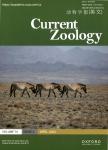The evolution of sexual imprinting in socially monogamous populations
The evolution of sexual imprinting in socially monogamous populations作者机构:Faculty of Life Sciences University of Manchester C. 1249a Michael Smith Building Dover Street Manchester M 13 9PL UK
出 版 物:《Current Zoology》 (动物学报(英文版))
年 卷 期:2015年第61卷第6期
页 面:1043-1061页
核心收录:
学科分类:0710[理学-生物学] 08[工学] 0905[农学-畜牧学] 09[农学] 0906[农学-兽医学] 0815[工学-水利工程] 0901[农学-作物学] 090102[农学-作物遗传育种]
基 金:BBSRC Research Experience Placement
主 题:一夫一妻制 印记 社会 群体性 交配系统 演变 动态系统模型 目标性状
摘 要:Sexual imprinting is a common mechanism of mate preference learning. It is thought to influence how traits evolve and in some cases to promote speciation. Recently there has been increasing interest in how sexual imprinting itself evolves. Theoretical work on polygynous mating systems predicts that females will evolve paternal imprinting, which means they learn to prefer phenotypes expressed by their fathers. In nature however, females of some species learn to prefer phenotypes expressed by their mothers instead. We used a dynamical systems model and tools from adaptive dynamics to study how sexual imprinting evolves in species with socially monogamous mating systems. We considered cases in which the target trait for imprinting is under viability selection but is not a reliable signal of paternal investment. Thus, the target trait signals the genetic benefits rather than the parental care benefits of mate choice. When mating is socially monogamous and there is some extra-pair paternity, we show that maternal imprinting can be favored over paternal imprinting. Counterintuitively, females often become choosier when selecting social partners in systems where extra-pair mating is more frequent. That is, females may be more selective when choosing social partners that will sire a smaller percentage of their offspring. Our results offer new testable hypotheses, and advance our understanding of the mechanisms that drive the evolution of mate choice strategies in nature.



